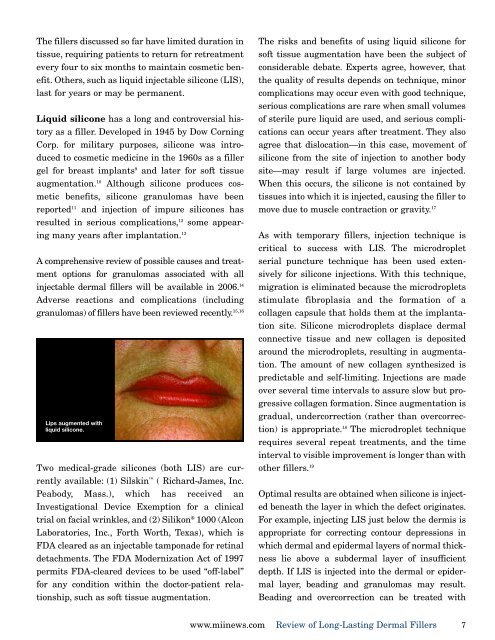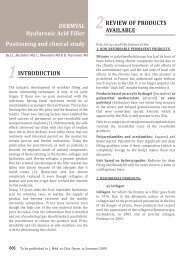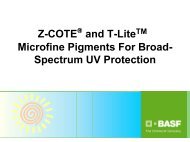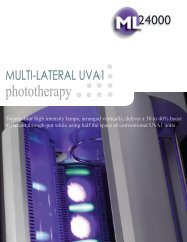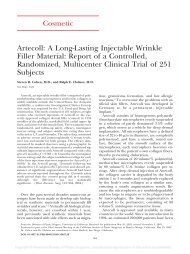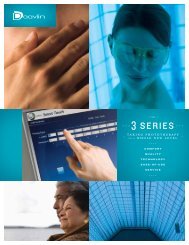Review of Long-Lasting Dermal Fillers
Review of Long-Lasting Dermal Fillers
Review of Long-Lasting Dermal Fillers
You also want an ePaper? Increase the reach of your titles
YUMPU automatically turns print PDFs into web optimized ePapers that Google loves.
The fillers discussed so far have limited duration in<br />
tissue, requiring patients to return for retreatment<br />
every four to six months to maintain cosmetic benefit.<br />
Others, such as liquid injectable silicone (LIS),<br />
last for years or may be permanent.<br />
Liquid silicone has a long and controversial history<br />
as a filler. Developed in 1945 by Dow Corning<br />
Corp. for military purposes, silicone was introduced<br />
to cosmetic medicine in the 1960s as a filler<br />
gel for breast implants 9 and later for s<strong>of</strong>t tissue<br />
augmentation. 10 Although silicone produces cosmetic<br />
benefits, silicone granulomas have been<br />
reported 11 and injection <strong>of</strong> impure silicones has<br />
resulted in serious complications, 12 some appearing<br />
many years after implantation. 13<br />
A comprehensive review <strong>of</strong> possible causes and treatment<br />
options for granulomas associated with all<br />
injectable dermal fillers will be available in 2006. 14<br />
Adverse reactions and complications (including<br />
granulomas) <strong>of</strong> fillers have been reviewed recently. 15,16<br />
Lips augmented with<br />
liquid silicone.<br />
Two medical-grade silicones (both LIS) are currently<br />
available: (1) Silskin ( Richard-James, Inc.<br />
Peabody, Mass.), which has received an<br />
Investigational Device Exemption for a clinical<br />
trial on facial wrinkles, and (2) Silikon ® 1000 (Alcon<br />
Laboratories, Inc., Forth Worth, Texas), which is<br />
FDA cleared as an injectable tamponade for retinal<br />
detachments. The FDA Modernization Act <strong>of</strong> 1997<br />
permits FDA-cleared devices to be used “<strong>of</strong>f-label”<br />
for any condition within the doctor-patient relationship,<br />
such as s<strong>of</strong>t tissue augmentation.<br />
The risks and benefits <strong>of</strong> using liquid silicone for<br />
s<strong>of</strong>t tissue augmentation have been the subject <strong>of</strong><br />
considerable debate. Experts agree, however, that<br />
the quality <strong>of</strong> results depends on technique, minor<br />
complications may occur even with good technique,<br />
serious complications are rare when small volumes<br />
<strong>of</strong> sterile pure liquid are used, and serious complications<br />
can occur years after treatment. They also<br />
agree that dislocation—in this case, movement <strong>of</strong><br />
silicone from the site <strong>of</strong> injection to another body<br />
site—may result if large volumes are injected.<br />
When this occurs, the silicone is not contained by<br />
tissues into which it is injected, causing the filler to<br />
move due to muscle contraction or gravity. 17<br />
As with temporary fillers, injection technique is<br />
critical to success with LIS. The microdroplet<br />
serial puncture technique has been used extensively<br />
for silicone injections. With this technique,<br />
migration is eliminated because the microdroplets<br />
stimulate fibroplasia and the formation <strong>of</strong> a<br />
collagen capsule that holds them at the implantation<br />
site. Silicone microdroplets displace dermal<br />
connective tissue and new collagen is deposited<br />
around the microdroplets, resulting in augmentation.<br />
The amount <strong>of</strong> new collagen synthesized is<br />
predictable and self-limiting. Injections are made<br />
over several time intervals to assure slow but progressive<br />
collagen formation. Since augmentation is<br />
gradual, undercorrection (rather than overcorrection)<br />
is appropriate. 18 The microdroplet technique<br />
requires several repeat treatments, and the time<br />
interval to visible improvement is longer than with<br />
other fillers. 19<br />
Optimal results are obtained when silicone is injected<br />
beneath the layer in which the defect originates.<br />
For example, injecting LIS just below the dermis is<br />
appropriate for correcting contour depressions in<br />
which dermal and epidermal layers <strong>of</strong> normal thickness<br />
lie above a subdermal layer <strong>of</strong> insufficient<br />
depth. If LIS is injected into the dermal or epidermal<br />
layer, beading and granulomas may result.<br />
Beading and overcorrection can be treated with<br />
www.miinews.com<br />
<strong>Review</strong> <strong>of</strong> <strong>Long</strong>-<strong>Lasting</strong> <strong>Dermal</strong> <strong>Fillers</strong><br />
7


